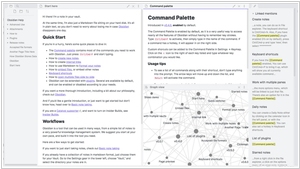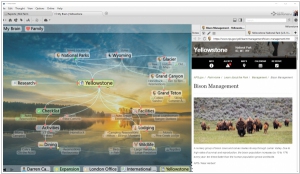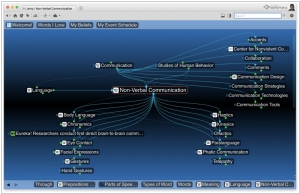Obsidian vs TheBrain
August 23, 2023 | Author: Adam Levine
21

Obsidian is a personal knowledge base and note-taking software application that operates on Markdown files. It allows users to make internal links for notes and then to visualize the connections as a graph. It is designed to help users organize and structure their thoughts and knowledge in a flexible, non-linear way.
Obsidian and TheBrain are both popular knowledge management tools designed to help users organize and connect their thoughts, ideas, and information. Obsidian distinguishes itself with its markdown-based approach, encouraging users to create interconnected notes using plain text files, stored in a local folder structure, and utilizing backlinks to establish meaningful relationships between ideas. It also boasts a thriving community and plugin ecosystem, enabling users to customize their experience. On the other hand, TheBrain focuses on visualizing information through dynamic mind maps, allowing users to create a web of interconnected thoughts and concepts. It offers a flexible interface, with the ability to add attachments and notes to nodes, enabling users to store diverse types of information.
See also: Top 10 Notebooks
See also: Top 10 Notebooks
Obsidian vs TheBrain in our news:
2018. TheBrain 9 gets new interface, attachment previews, timeline and mind mapping view

TheBrain Technologies has unveiled the latest version of its dynamic visualization and knowledge management software, TheBrain 9. This release introduces a range of new features, including a brand-new native user interface that allows for seamless scaling to accommodate millions of objects. With a more powerful and robust backend, TheBrain 9 delivers faster startup times, improved responsiveness, and enhanced scalability. The software has been completely rewritten as a native application, optimizing it for specific features on Windows, macOS, iOS, and Android platforms. The updated version introduces a highly versatile timeline with a zooming interface, enabling smooth transitions from single-day to multi-year views. Events can be synchronized with Google Calendar and directly associated with thoughts and links. The advanced content display functionality offers built-in viewing of attachments, enhancing the overall user experience. The new Notes editor provides a clear separation between content and presentation, facilitating flexible idea capture that can be easily styled. Additionally, the mind map view dynamically generates a traditional mind map display from any starting point within a Brain, granting users convenient one-click access to a multitude of topic-specific notes, files, web pages, and other attached content.




